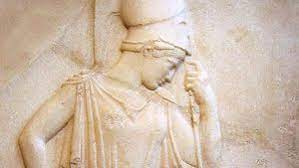ORIGIN
Greek. Goddess of war and patron defender of many Greek cities.
KNOWN PERIOD OF WORSHIP
circa 800 BC and earlier until Christianization (circa AD 400) and later.
SYNONYMS
Athene; PALLAS ATHENAE (maiden goddess of Athens); MINERVA (Roman).
CENTER(S) OF CULT
Athens but also Argos,Sparta, Gortyn, Larisa (Thessaly); Lindos and Ilion (Homer’s Troy).
ART REFERENCES
the Parthenon frieze and other sculptures and iconography throughout the Greek world, including notably the Athena of Phidias (Varvakeion) and the metope of Olympia in which she assists HERAKLES to support the sky.
LITERARY SOURCES
Iliad and Odyssey (Homer); Theogony and Hymn to Pallas Athene (Hesiod).
Athena is a principal goddess of the Greek pantheon and, according to Hesiod, the daughter of METIS (wisdom) born fully armed from the head of ZEUS.
A goddess of battle and allegedly a snake goddess, she is a deity who also stands for discipline against the more unruly conduct of such as
HERMES and POSEIDON.
Her most famed sanctuary is the Parthenon.
The olive tree is sacred to her, particularly that grown by tradition on the Acropolis, whose oil was given to the victors in the Panathenaia festival.
According to legend, she offered the olive to mankind.
Her symbol is the aigis—the skin of a sacrificial goat.
She is also associated with ship-building and with domestic crafts including wool work and spinning— Athenian women have traditionally woven the peplos at the Panathenaia festival.
In legend, she is the destroyer of Ajax and lures Hector to his death, while supporting such heroes as Perseus against the Gorgon monster, and Diomedes against ARES.
She also acts as a moderating influence in Achilles’ conflict with Agamemnon, the most notable instance of her characteristic ability for self-control.

